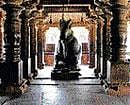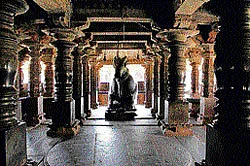

Well, you cannot expect oranges to be served in the house of the state’s most well-known and awarded pineapple farmer.
Rauf Saheb’s story is a rags-to-riches one. Born into an impoverished life, he eventually become the owner of the largest pineapple farm and processing plant around Sirsi.
In the course of the evening, I was introduced to an archaeologist from Australia over the phone. I wanted to know about Banavasi, the archaeologist wanted to know about the town that existed a few thousand years back. Rauf Saheb thought it fit that we explore the place together.
And so we did. We combed the vast stretches outside the village methodically. Historians and archaeologists are still interested in knowing more about the capital of the Kadamba dynasty, ‘Vanavasika’ or ‘Banavasi’ as it is called now. Later, during my stay, I even touched a small bit of that past when the hosts said that the well inside their house, next to the dining area under the sky light, was from that period.
Stepping into Banavasi, I had half expected to set foot into the brightly coloured canvas of Amar Chitra Katha, (the comics depicting mythological characters) because of the famous poet, Pampa’s description of the place: “It is a virtue to be born in Banavasi as a human being. If not as a human being, then at least one should be born as a bee or a cuckoo in the garden of Banavasi.” Reality was not wholly disappointing. Lakes full of pink lotuses, stretches of tall arecanut trees and plantain farms, fog lifting from the distant hills...
So, we stepped on to the quiet, clean village streets, flanked by houses made of mud and wood. We met Halesh Kerudi, the working member of the Village Tourism Committee at his place. The local communities play a key role by being part of the committee, and contribute to the tourism initiative.
The town is built around the Madhukeshwara temple, so called for the honey-coloured linga that is worshipped as the main deity. The temple was built by the Kadambas in 325 – 525 AD, but additions were made to it by successive rulers; the architectural shifts indicating the individual styles of the many dynasties that ruled the place. The ruins of the Jain and Buddhist temples, the splendour of the Madhukeshwara temple and a community still thriving and celebrating plurality both intrigued and gladdened me.
Banavasi, which is nestled in the Western Ghats, is a bio-diversity hotspot. The Varada river circumnavigates the town, making it a quaint piece of land with a rich past, embraced by a river in spate, that has submerged the paddy fields, though there’s the comfort of knowing that the endogenous strain of rice will thrive after it recedes. This region has about 150 strains of native rice.
Banavasi has many craft communities, some from times of yore, supporting the local
customs and traditions, and some from the recent entrepreneurial times. Local families run khanavalis that serve up a delectable spread of the region’s cuisine. A good way of burning it up was a walk to the quiet stillness of the Gadanur lake to watch the sun set and the birds take off. The other places of interest are the Gudavi Bird Sanctuary, the rock formations at Yana, the intrigue of Chandragutti with its Devadasi past (and present, as some say), Jog falls and many more.
